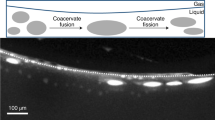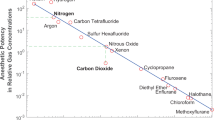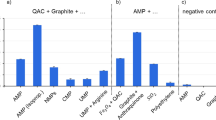Abstract
Results from simulation experiments in the laboratory support the Oparin–Haldane hypothesis of chemical evolution1–4. The organic compounds produced may have accumulated in the primitive sea, constituting the so-called ‘primordial soup’ of organic molecules. Beyond this primordial stage, however, many developments were required before the emergence of the first cellular organism. The first cell need not necessarily have been a modern cell, complete with a membrane, a chromosome, ribosomes, enzymes, a metabolism, and the property of self-replication; the primary requirement of the protocell would have been the ability to evolve into a complete cell. There are many models of the protocell: for example coacervate droplets5–9, proteinoid microspheres10,11, micelles (lipid vesicles)12, and marigranules13,14. Of these, the coacervate droplets are of interest as they are dynamic6,7 and because their mechanism of formation is perhaps better understood15–16. Coacervate droplets are essentially small bounded spaces in which the concentration of substances is higher than in the surrounding medium and in which the distribution of the substances differs from that in the solutions. Their essential functions in the protocell model are: (1) selection; (2) concentration; (3) production of hypohydrous effects; (4) interaction; and (5) organization5–9. Here we report another possible function of the coacervate. We added glycine or diglycine to the coacervate system, then irradiated the system with an argon lamp. We report that the coacervate droplets concentrated glycine or diglycine, thus protecting them from decomposition by irradiation. These results suggest a protective function of the coacervate against UV light on the primitive Earth.
This is a preview of subscription content, access via your institution
Access options
Subscribe to this journal
Receive 51 print issues and online access
$199.00 per year
only $3.90 per issue
Buy this article
- Purchase on Springer Link
- Instant access to full article PDF
Prices may be subject to local taxes which are calculated during checkout
Similar content being viewed by others
References
Miller, S. L. Science 117, 528–529 (1953).
Ponnamperuma, C. Cosmochemistry (ed. Milligan, W. O.) 137–197 (Robert A. Welch Foundation, Houston, 1978).
Miller, S. L. & Orgel, L. E. The Origins of Life on the Earth (Prentice-Hall, New Jersey, 1974).
Dillon, L. S. The Genetic Mechanism and the Origin of Life Ch. 1 (Plenum, New York, 1978).
Bungenberg de Jong, H. G. Colloid Science Ch. 10 (Elsevier, Amsterdam, 1949).
Oparin, A. I. The Origin of Life (Macmillan, New York, 1938).
Evreinova, T. N. Coacervates (Kyoritsu, Tokyo, 1974).
Mizutani, H., Okihana, H., Hasegawa, M., Yano, T. & Noda, H. The Origin of Life and Evolutionary Biochemistry (eds Dose, K., Fox, S. W., Deborin, G. A. & Pavlovskaya, T. E.) 339–354 (Plenum, New York, 1974).
Noda, H., Mizutani, H. & Okihana, H. Origins of Life 6, 139–146 (1975).
Fox, S. W., Harada, K. & Kendrich, J. Science 129, 1221–1223 (1959).
Fox, S. W. The Origins of Prebiological Systems and of Their Molecular Matrices (ed. Fox, S. W.) 361–373 (Academic, New York,1965).
Goldace, R. J. Surface Phenomena in Chemistry and Biology (eds Danielli, J. R., Pankhurst, K. G. A. & Riddiford, A. C.) 276–278 (Pergamon, London, 1958).
Yanagawa, H. & Egami, F. Proc. Japan Acad. 53, 42–45 (1977).
Okihana, H. Viva Origino 8, 19–22 (1979).
Okihana, H. & Noda, H. Origin of Life (ed. Noda, H.) 375–383 (Japan Scientific Press, Tokyo, 1978).
Tainaka, K. Biopolymers 19, 1289–1298 (1980).
Okihana, H. & Nakajima, A. Bull Inst. chem. Res. 54, 63–71 (1976).
Rushbrook, P., Ponnamperuma, C. & Reinisch, R. F. Abstr. Pacific Conf. Chemistry and Spectroscopy, Am. Chem. Soc. Meet., San Francisco (1970).
Author information
Authors and Affiliations
Rights and permissions
About this article
Cite this article
Okihana, H., Ponnamperuma, C. A protective function of the coacervates against UV light on the primitive Earth. Nature 299, 347–349 (1982). https://doi.org/10.1038/299347a0
Received:
Accepted:
Issue Date:
DOI: https://doi.org/10.1038/299347a0
This article is cited by
-
Connecting primitive phase separation to biotechnology, synthetic biology, and engineering
Journal of Biosciences (2021)
-
The evolution of prebiological self-organization: Probable colloid-chemical evolution of first prokaryotic cells
Origins of Life (1984)
Comments
By submitting a comment you agree to abide by our Terms and Community Guidelines. If you find something abusive or that does not comply with our terms or guidelines please flag it as inappropriate.



